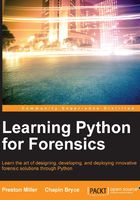
Conventions
In this book, you will find a number of text styles that distinguish between different kinds of information. Here are some examples of these styles and an explanation of their meaning.
Code, variables, function names, URLs, or other keywords are written in a specific font, for example. Variables are lower case with underscores separating words. Functions or class names are follow the CamelCase convention (for example, processData) where the first word is lowercase and any following word is capitalized. Function, method, or class names will also by followed by a pair of parenthesis to logically separate them from variables. We will display all code meant for the Python interactive prompt or in a file.
A block code written in the interactive prompt is preceded by three ">" or "." symbols emulating what a user would see when typing the data into the interactive prompt.
Python Interactive Prompt Code >>> a = 5 >>> b = 7 >>> print a + b 13
A block of code written in a file will contain a line number on the left side of the file followed by the code on that line. Indentation is important in Python and all indents should be at increments of 4 spaces. Lines may wrap due to margin lengths. Please refer to the provided code for clarification on indentations and layout.
Python Script 001 def main(): 002 a = 5 003 b = 7 004 print a + b